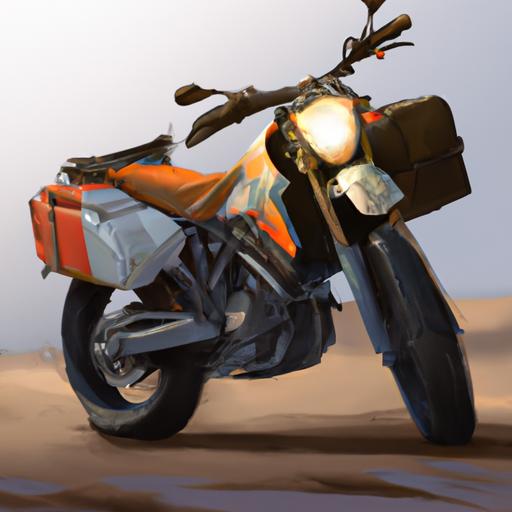Touring bikes are a great way to explore new places and to get some exercise.
But why are they so heavy? For cyclists, weight is an important factor, as it can drastically affect the ride quality.
In this article, we’ll take a look at why touring bikes are heavier than other types of bikes, and what benefits this weight provides.
We’ll explore how the frame, components, and other features contribute to the overall weight, and how that affects the ride quality.
By the end, you’ll have a better understanding of the advantages and disadvantages of a heavier touring bike.
Table of Contents
Short Answer
Touring bikes are designed to be strong and durable in order to withstand the wear and tear of long distance travel.
They are usually made with steel frames and beefed up components in order to provide the rider with a comfortable, reliable ride over a variety of terrain.
Additionally, they often feature racks and other accessories to provide riders with the necessary cargo capacity for their journey.
All these features add weight to the bike, making them heavier than traditional road bikes.
Components That Contribute to the Weight of Touring Bikes
When it comes to the weight of a touring bike, there are several components that contribute to the overall heft.
These components include the frame, wheels, tires, brakes, drivetrain, and accessories.
The frame of a touring bike typically includes a strong, durable material such as steel, aluminum, or titanium, which adds to the overall weight.
Steel frames are known for their strength and durability, but they come at the cost of extra weight.
Aluminum frames are lightweight and affordable, but may not be as durable as steel frames.
Titanium frames offer superior strength and durability, but at a higher cost.
The wheels and tires of a touring bike must also be strong and durable to handle the added weight of the rider and any luggage.
Touring bike wheels are usually made from heavier materials such as steel, aluminum, or carbon, and are designed to be able to handle off-road terrain.
The tires of a touring bike are usually wider than those of other bikes to provide extra grip and traction.
The brakes on a touring bike must also be able to handle the added weight of the rider and their luggage.
Touring bike brakes are typically constructed with heavier materials such as steel or aluminum, and are designed to be able to handle heavier loads.
The drivetrain of a touring bike is also built to handle the extra weight of the rider and their belongings.
Touring bike drivetrains are typically constructed with heavier materials such as steel or aluminum, and may include multiple chainrings and cassette sprockets to provide added gears for tackling different terrain.
Finally, accessories such as racks, fenders, and lights can add to the overall weight of a touring bike.
These accessories are designed to be able to handle the additional weight of the rider and their luggage, and may be made from heavy-duty materials such as steel or aluminum.
When all of these components are combined, they can add up to a surprisingly hefty amount of weight.
Touring bikes are designed to be able to handle the rigors of extended travel, and their heavier components and accessories help ensure that they can withstand the additional abuse.
The Need for Heavier Frames

When it comes to touring bikes, the heavier frame is necessary for a number of reasons.
First and foremost, these bikes need to be able to handle a greater load than traditional road or mountain bikes.
Touring bikes are designed to be able to carry the rider, their luggage, and any other items they may be carrying, so they need to be able to withstand the greater weight.
Additionally, they are made to be able to handle a variety of terrain, from smooth roads to rugged off-road terrain.
This means that the heavier frame material is required to provide the strength and durability needed to handle the additional abuse.
Another factor to consider is the fact that touring bikes are typically used for extended periods of time, often for weeks or months at a time.
This means that the frame and components must be able to withstand the wear and tear of constant use over such a long period.
Higher quality, heavier materials are needed to ensure that these bikes can stand up to the rigors of regular use.
Finally, the heavier frame also adds stability to the bike, making it easier to handle on rougher terrain.
The extra weight helps to keep the bike steady, allowing the rider to stay balanced while riding on uneven surfaces.
This makes touring bikes better suited for the type of riding they are designed for, and adds to their overall durability.
Ability to Handle More Weight
Touring bikes are designed to be able to handle more weight than other bikes due to their use in extended travel.
The bike must be able to take the load of the rider, their luggage, and any other items they may be carrying.
This requires the frame to be sturdier and the components to be heavier than other bikes.
The frame is typically made from steel or aluminum alloy, both of which are heavier than the carbon fiber frames used in other bikes.
Additionally, the components such as the wheels, gears, crankset, and brakes need to be more robust in order to accommodate the extra weight that will be put on them.
This can add to the overall weight of the bike.
Ruggedness and Durability

When it comes to touring bikes, it is important to note that they are designed with ruggedness and durability in mind.
This is because they are meant to withstand the rigors of extended travel, and must be able to handle a variety of terrain, from smooth roads to rough off-road terrain.
To this end, the frames and components of touring bikes tend to be heavier than those found on other bicycles.
This is due to the fact that they must be able to bear the additional weight of the rider, their luggage, and any other items they may be bringing along with them.
Additionally, the heavier frames and components help to ensure that the bike is able to handle the extra abuse it is expected to endure over long distances and on different terrains.
In short, all of these factors contribute to the heavier weight of touring bikes.
Ability to Handle Multiple Terrains
Touring bikes are designed to be able to handle a variety of terrain, from smooth roads to rough off-road terrain.
This is accomplished through heavy-duty frames and components, designed to withstand the rigors of extended travel.
The frame is constructed from robust materials such as steel, titanium, or aluminum, making it strong enough to handle the additional abuse of a variety of terrains.
Additionally, the components of a touring bike are designed to be able to handle more weight, which is beneficial for those who plan on carrying luggage or other items on their bike.
The tires are also made of durable materials, with reinforced sidewalls and treads to provide extra grip on rough terrain.
This combination of heavy-duty frame and components adds to the overall weight of a touring bike, making it heavier than other bikes.
Effect on Ride Quality

When it comes to the ride quality of a touring bike, its extra weight can be both a blessing and a curse.
On the one hand, the heavier frame and components make the ride more stable and secure, providing the rider with a feeling of confidence as they traverse various terrains.
On the other hand, the added weight can make the bike more difficult to maneuver, especially when navigating tight spaces or going up steep inclines.
Additionally, the extra weight can make the bike slower, especially when climbing hills.
However, the extra weight can also mean greater shock absorption, which is beneficial for those riding for extended periods of time over rough terrain.
The heavier frame and components can also make the bike more durable and less prone to damage, which is important for those who will be touring for long distances or over difficult terrain.
Overall, the extra weight of a touring bike can be a trade-off in terms of ride quality.
While it can make the bike slower and less maneuverable, it can also provide greater stability and durability, which can be beneficial in the long run.
Ultimately, it’s up to the rider to decide if the benefits of the extra weight outweigh the drawbacks.
Benefits of Heavier Touring Bikes
Touring bikes are built with heavier frames and components than other bikes due to their need to handle the rigors of extended travel.
While this may seem like a downside to some, there are numerous benefits to having a heavier touring bike.
For starters, the additional weight makes the bike more stable, which is especially beneficial on varying terrain.
Additionally, the heavier frame and components hold up better in windy conditions, allowing for a more comfortable ride.
Furthermore, the fact that these bikes can carry more weight, including the rider, their luggage, and any other items, makes them ideal for long-distance riding.
The additional padding and suspension also helps to absorb more bumps and shocks from the road, resulting in a smoother and more comfortable ride.
Finally, a heavier frame and components are usually more durable, making them better suited for long-term use and travel.
Ultimately, all of these factors make touring bikes a great choice for those looking for a reliable and comfortable ride over extended distances.
Final Thoughts
Touring bikes are designed with heavier frames and components to give riders the best possible experience when they hit the road.
They are built to withstand the rigors of extended travel, carry more weight, and handle a variety of terrains.
All of these factors contribute to the heavier weight of touring bikes, but they also bring with them the benefit of superior durability, ride quality, and safety.
If you’re looking for a bike that can take you on a long journey, then a touring bike is the perfect choice.

